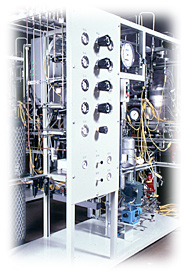|
Generally the first stage in the
extraction of crude oil is to drill a well into the
underground reservoir. Historically, in the USA some oil
fields existed where the oil rose naturally to the surface,
but most of these fields have long since been depleted. Often
many wells will be drilled into the same reservoir, to ensure
that the extraction rate will be economically viable. Also
some wells may be used to pump water, steam or various gas
mixtures into the reservoir to raise or maintain the reservoir
pressure, and so maintain an economic extraction rate.
If the underground pressure in
the oil reservoir is sufficient then the oil will be forced to
the surface under this pressure. Gaseous fuels or natural gas
are usually present, which also supplies needed underground
pressure. In this situation it is sufficient to place a
complex arrangement of valves on the well head to connect the
well to a pipeline network for storage and processing.
Over the lifetime of the well
the pressure will fall, and at some point there will be
insufficient underground pressure to force the oil to the
surface and the remaining oil in the well must be pumped out.
Various techniques aid in
recovering oil from depleted or low pressure reservoirs,
including Beam Pumps, Electrical Submersible Pumps (ESPs), and
Gas Lift. Other techniques include Water Injection and Gas
Re-injection, which help to maintain reservoir pressure.
|

